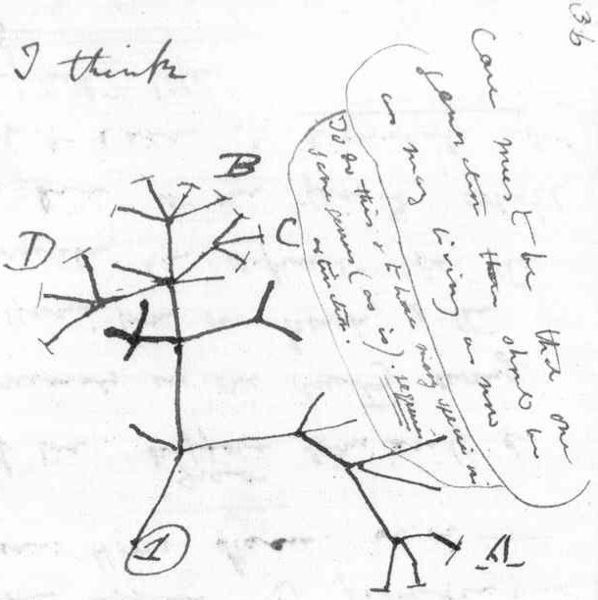Charles Darwin is considered a pioneer in terms of empirical science. His theory of evolution is widely used today. But, what some people don’t realize is that apart from writing a scientific novel, Darwin also wrote a great piece of literature. He uses several different poetic devices that, at least for me, truly help to develop the ideas of his theory in a way that’s easy for the reader to understand and picture.

Darwin’s first attempt at mapping out his tree of evolution.
“The affinities of all the beings of the same class have sometimes been represented by a great tree. I believe this simile largely speaks the truth. The green and budding twigs may represent existing species; and those produced during each former year may represent the long succession of extinct species.” (Darwin, On the Origin of species)
When I read this passage, I think, Darwin did a fantastic job at explaining his theory. His overall argument is that species evolve from one another, and that those species with similar traits to others have a less likely chance at survival. He titled this theory Natural Selection and it’s widely used among the fields of environmental studies.
As I read this selection, I felt like I could truly visualize what Darwin was thinking. A tree contains both new and old twigs and branches. The most flourishing ones, in this instance, represent the most current species, while the older branches depict the species that have become extinct for any various reasons. Personally, I feel that this is incredible writing, given the nature that Darwin was alive.
I presumably see a very subtle, and clever, tie between the tree analogy and his theory of Natural Selection. A tree is a living multi-cellular organism that must compete for survival amongst the similar living objects of its species. For example, trees that grow very near one another must compete for the direct amount of resources in the vicinity.
It’s remarkable to me that Darwin chooses another living object that directly uses his theory, to represent his theory. As an avid reader, I tend to usually like see an analogy that incorporates anthropomorphism; or giving human like characteristics to non-human objects, but this one does a fantastic job at describing his theory. It was extremely clever on his part to analogize an object that uses his theory. It gives me two different perspectives to visualize his interpretation of this natural phenomenon.

After several years, Darwin produced this image, which represents a larger form of his original tree.
There’s another example in this same passage where Darwin uses analogy to describe his theory:
“Of all the twigs which flourished when the tree was a mere bush, only two or three, now grown into great branches, yet survive and bear all the other branches;…” (Darwin, On the Origin of Species)
It’s really fascinating to me that Darwin expands on his original metaphor of the tree. He originally stated that the older branches on a tree may represent the extinct species, and now he’s stating that there are only a few branches left, proving his theory in that only a few branches (or species) can survive in a given area. By area, I am directly referencing the single tree to which this analogy refers.
This passage shows both ends of his theory. He allows the reader to visualize a tree with many old branches, indicating the extinct species, while also allowing the reader to see the few that survived; which accurately represents the main argument of this chapter, in that nature will naturally “weed out” the species that can’t survive, and that those of similar cellular structure will have to compete to see who can be one of “the branches” that make it through to the next year.

I agree that it is interesting that Darwin uses one natural object or organism (the tree) as a metaphor to help us imagine a more abstract natural process (evolution). I often think of metaphors as either a) making the unfamiliar familiar (by comparing something foreign to us to something that we are used to) or b) making the familiar unfamiliar (by comparing something we are used to to something that is foreign to us). I think Darwin’s use of the tree as metaphor definitely makes something unfamiliar more familiar, but it also seems to preserve the wonderment and weirdness of the unfamiliar. For example, trees don’t usually cover the whole surface of the earth with their “ramifications.” This is definitely a special, and somewhat weird, tree, but yet it is nonetheless beautiful. I love imagining what it would look like in real life. Great post!